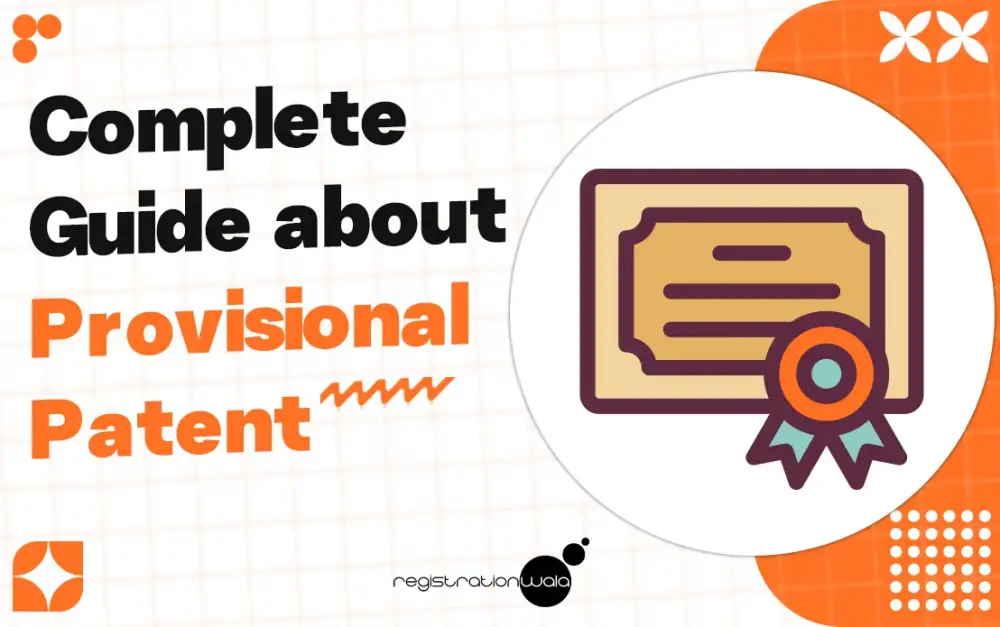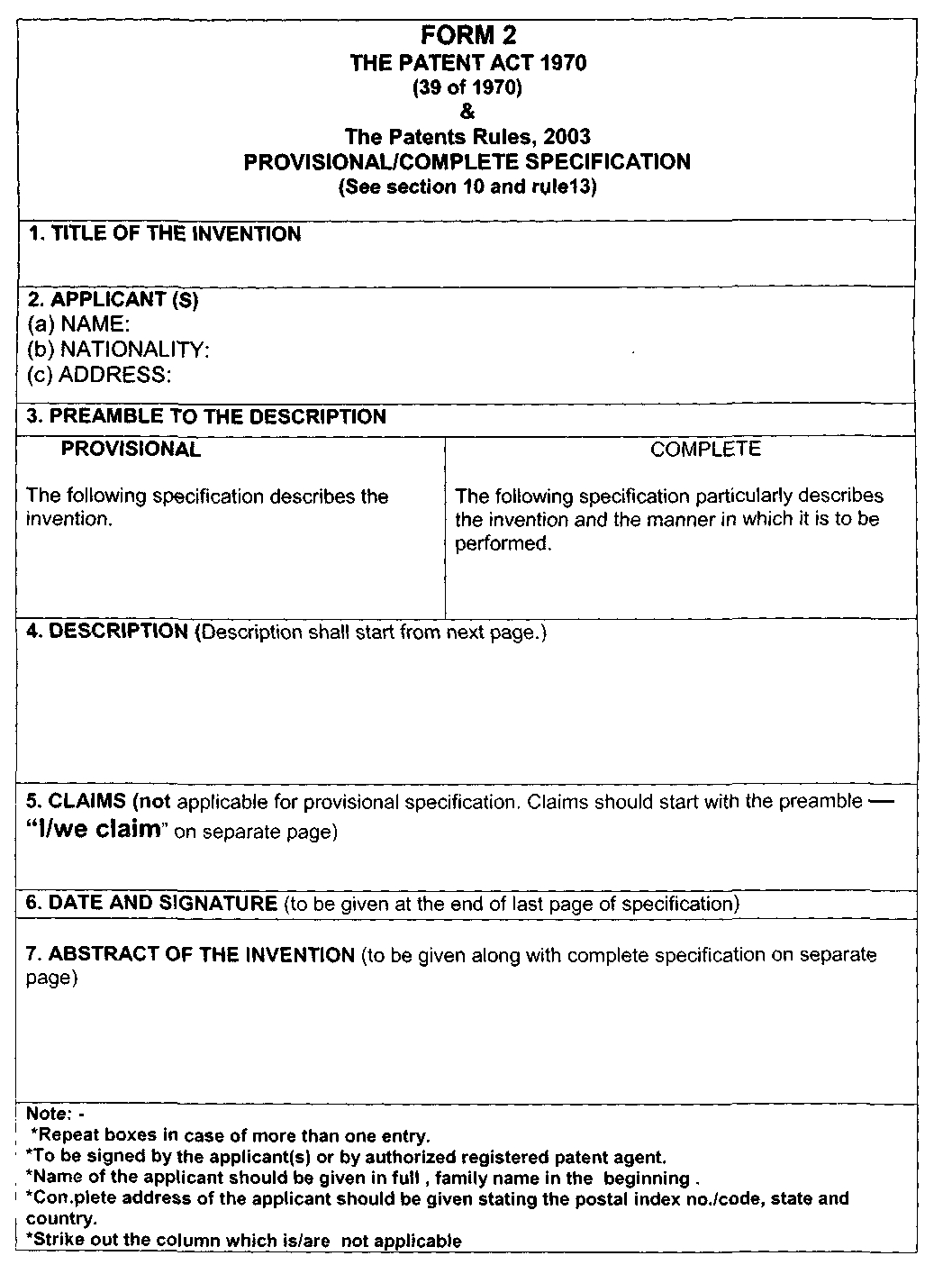Complete Guide about Provisional Patent
- March 23, 2024
- Registrationwala

- Home
- /
- Knowledge Base
- /
- News & other businesses
- /
- Blog
- /
- Complete Guide about Provisional Patent
Complete Guide about Provisional Patent
A provisional patent is a kind of a temporary patent application which protects the invention of the inventor for a period of 12 months while the invention is in the stage of development and the inventor is preparing to file a non-provisional patent application.
The patent office does not examine the provisional patents but it does provide the inventor a filing date through which he or she can claim priority for his or her application for a non-provisional patent. Once the required documents and researched work are completed, the inventor can file a complete patent application. It is a completely optional step to file a provisional patent application. In case you are at a stage where you have all the details regarding your invention, you can opt for complete specification.
This article will serve as a complete guide about the provisional patent.
Why do inventors file Provisional Patent Application even though it is not mandatory?
Since it is a completely optional step to file a provisional patent application, you must wonder why people feel the need to file it. The reason is, a provisional patent application enables the invention to get protection even before the complete specification is filed. Enormous detailing about the invention is necessary when it comes to drafting a complete specification. Completing the R&D for most inventions is painstaking and can take many months. If one waits to figure out the invention first and then file the complete specification, it can be a very complicated process. Hence, by filing a provisional specification with the invention’s basic details, the inventor can get a priority date fixed. In addition to this, a provisional patent application does not mandate the invention’s claims or diagrams and it is way cheaper to file this kind of application.
After having filed the provisional patent application, the inventor is granted 12 complete months to work on his inventions and decide on the claims upon which the complete specification will be filed. Hence, we can say that a provisional patent application acts as an interim protection to inventors and buys them more time for working on their inventions. An inventor is permitted to do marketing for his invention once the provisional patent application is filed. However, he must label such an invention as ‘Patent Pending’ invention. Marketing the invention would inform the public and the potential competitors that no one is permitted to imitate or attempt to market such an invention since the inventor is already working on it to get it patented by the patent office.
Merits of Provisional Patent Application
There are many merits of provisional patent application which encourage inventors to file it:
- Relatively inexpensive: It is much cheaper to file a provisional patent application compared to a complete patent application.
- The invention can be labeled with “Patent Pending” status: Even though a provisional patent is not an actual patent and will not be converted into one unless further steps are taken, the inventor is legally entitled to label his invention with “patent pending” once the provisional patent application has been filed.
- Allows time for the invention’s evolution: It can be a mistake to file a complete patent application while the invention is in its initial stage as this may not protect your invention adequately. This is why, in place of a complete patent application, it is more appropriate to file a provisional patent application which secures your priority date and gives you sufficient time to work on your invention which ensures that it can reach its fullest potential.
- Allows time for testing the invention’s commercial potential: After the inventor has secured the priority date upon filing a provisional patent application, he can test out the willingness of other businesses to license his invention then patented. He can also get an understanding of the invention’s commercial worth and have enough time to conduct market research and test commercial potential.
- In the 12 months provided upon provisional patent application, the inventor can easily make out whether he wants to move forward with complete patent application or back out based on the results of his market research and commercial worth of the patent, without worrying about its confidentiality.
- You may abandon the provisional patent application: If you feel like the invention for which you have already filed provisional patent is not worth filing a complete patent application for, you can abandon it. It’ll save up your money.
- You might want to abandon the provisional patent application if you feel like the invention doesn’t hold much commercial value or because no one’s willing to purchase or license it and you’re not keen on producing the invention either. Imagine all the money you’d have to pay in case of a complete patent application just to abandon the application ultimately. This is why provisional patent application is a better option when the patent is in its initial stages.
Mistakes to Avoid in Provisional Application
While filing a provisional patent application for your invention, you need to be careful to avoid any mistakes.
- A provisional application for a patent is a scope defining document, not just a rough draft of your invention or idea. Every part of your invention which lies beyond the provisional application’s scope but you happened to develop it in 12 months will have to have the earlier priority date. This means that if a part of your invention is developed after a provisional patent application is filed and this part is outside the scope set by application, it will not have the benefit of priority date.
- Filing complete specification later does not replace the provisional specification since the latter still remains in the record. The filing date and patent application number to the provisional application received is allocated by the patent office.
- If you want to file a complete specification, make sure you do it within a period of 12 months from the date of filing provisional specification. After the 12 months expiry period, the patent application is considered to be abandoned.
- Do not make the mistake of not disclosing the scope of invention properly.
- Do not publicly disclose the part of the invention which is not granted protection by provisional specification. Doing so would destroy the invention’s novelty for the part which is not covered.
- The language used in patent application plays a crucial role in defining the invention’s scope. So, make sure the invention’s description is not limited. While writing down the invention’s description, avoid using limiting words like “must have”, “essential” or “consists”. Instead of such words, you can use terms like “writing device” instead of “pen” which would be a limiting scope and eliminate other writing devices like “marker” or “pen” from the scope. While applying for patent registration, a provisional or complete specification (Form 2) must be filed. Specification can be filed either as a provisional or a complete specification depending on the inventor’s requirement. Provisional specification is filed alongside patent application to secure a priority date for the application over other applications which can be filed for the same invention being developed concurrently.
Contents of Provisional Specification
The following are the contents of provisional specification:
- Title of the invention
- Applicant’s name, nationality and address
- Description of the invention starts with preamble ‘The following Specification describes the invention’
- The description contains
- The field of invention and containing the background of the invention
- The object of the invention and statement of the invention
- Claims may not be part of the Provisional Specification
A provisional patent application is an excellent idea to save costs while protecting your invention or idea. It provides you a period of 12 months to test the invention’s true potential before opting for the full patent procedure.
What are the drawbacks of filing a provisional patent application?
The major drawback of filing a provisional patent application is that it does not offer protection for any patent on its own. The patent application period ends after 12 months. The inventor will be required to file a non provisional patent application during the period of 12 months if he or she plans to move forward with the patent process.
What should the inventor do when provisional patent application expires?
If the provisional patent application has reached its expiration date and you’ve failed to file a non provisional patent application, the inventor will lose his patent rights. However, a fresh provisional patent application can be filed for the same invention. But, in this case, he or she will not be able to claim priority to the filming date as per his or her original patent application.
How many times can a provisional patent be renewed?
A provisional patent application cannot be renewed. It is only a one time filing which comes with a validity of 12 months. Once this period ends, it expires and the inventor is required to file a non provisional patent application if he wants to carry on with the patent process.
When should an inventor file a non-provisional patent application?
The inventor must file a non provisional patent application before the expiration date of provisional patent application i.e., within a period of 12 months from the date on which the provisional patent application was filed. However, he or she can file a non provisional patent application earlier in case he or she has already developed his or her invention and wants to seek patent protection.
Conclusion
Filing an application for a provisional patent is a good idea for those inventors who want to receive a filing date for their invention and have sufficient time to further develop the invention before they file a non provisional patent application. However, it is necessary to note that provisional patent application does not provide protection for the invention on its own. In order to continue with the patent process, you need to file a non-provisional patent application within a period of 12 months from the date the provisional patent application was filed. For assistance in filing a provisional patent application, you can get in touch with the Registrationwala team.
- 1190 views

